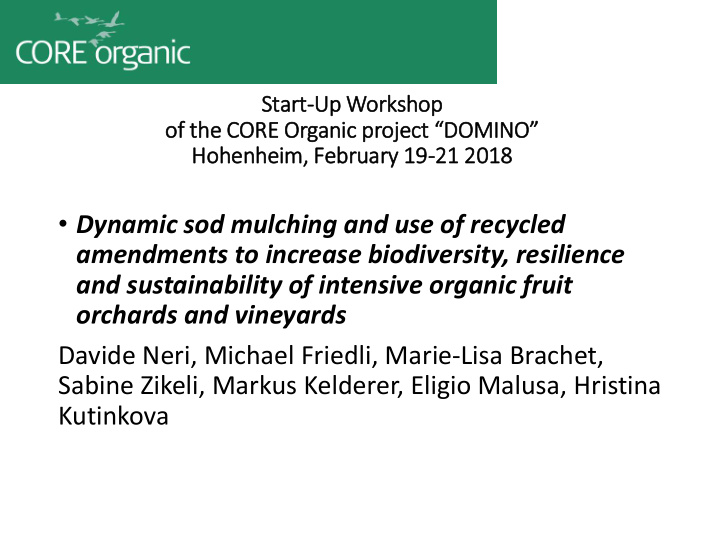



Start-Up Workshop of of th the CORE Organic project “DOMINO” Hoh ohenheim, February 19 19-21 20 2018 18 • Dynamic sod mulching and use of recycled amendments to increase biodiversity, resilience and sustainability of intensive organic fruit orchards and vineyards Davide Neri, Michael Friedli, Marie-Lisa Brachet, Sabine Zikeli, Markus Kelderer, Eligio Malusa, Hristina Kutinkova
D ynamic s o d m ulch in g and use of recycled amendments to increase biodiversity, resilience and sustainability of intensive o rganic fruit orchards and vineyards DOMINO Project coordinator: Davide Neri Dept. of Agricultural, Food and Environmental Sciences Polytechnic University of Marche, Ancona, Italy Polytechnic University of Marche, Ancona, Italy Productivity Consumers Fruit quality Suppressivity Farmers
Ratio ionale le 1 The DOMINO project aims to improve long-term sustainability of intensive organic orchard and vineyard by innovative strategies expected to increase biodiversity as a source of resilience for the agroecosystems, and to reduce the dependency on external inputs. Modified from Zucconi, 1996
Ratio ionale le 2 • DOMINO focuses on the interaction of fruit trees with different wild species, organic residues and microbioma. • It intends to break the paradigm of monoculture in organic fruit growing by the development of new intercropping strategies and amendments to increase the sustainability of organic fruit growing and to maintain ecosystem services. Zucconi, 1996
DOMINO consortium and lo location UPM Polytechnic University of Marche, Italy FGI Fruit Growing Institute, Bulgaria LAIM Laimburg Research Centre, Italy INHORT Institute of Horticulture, Poland CTIFL C.T.I. Fruits Légumes, France FiBL R.I. of Organic Agriculture, Switzerland BioS BioSudtirol, Italy BioS Vip Vi.P Bio Vinschgau, Italy Vip INHORT BLand Bioland Südtirol, Italy BLand SBR SBR SBR organic, Italy AIAB Ass. It. Agricoltura Biologica, Italy UHOH University Hohenheim, Germany UHOH FiBL FOKO Fördergemeinschaft Ökologischer FOKO Obstbau e.V., Germany CTIFL LAIM FGI AIAB UPM
St Stru ructure of f th the DOMIN INO consortiu ium and in interactio ion among WPs
The proposed strategy includes: • i) the introduction of new cash intercropping species, expected to contribute to plant nutrition and protection while increasing biodiversity; • ii) the use of recycled organic amendments from composted waste and digestate to improve soil fertility and suppressiveness, as well as carbon balance of the system; • iii) the introduction of microbial-based products for plant nutrition and protection to promote soil biodiversity and enhance inputs efficiency; • iv) the introduction of overhead netting and partial cover systems for crop protection; • v) the overall designing of orchard management to promote eco-services.
Methodology • The project is based on a multi-stakeholder approach which includes different actors (farmers, extension, researchers, agricultural administration) • The design of the trials, the choice of the products and plants (fertilisers, soil amendments, microbial products, intercrops) tested, involves farmers in on- farm trials in order to modify practices developed by researchers for practical application • It links up with organic associations and other local actors for data collection and dissemination
After a description and documentation on the status quo of organic orchard management (fertilisation, intercropping, sod management) in different European countries (Italy, Switzerland, Germany, Poland, France, Bulgaria), the DOMINO project focuses on the following topics: Fabio Marchionni organic vineyard in Castelraimondo, Marche, Italy
• Development of new strategies to manage the sod and the intrarow space between fruit trees by increasing the biodiversity of the orchards (use of stoloniferous intercrops, use of legumes and other species as living mulches) • Optimization of fertilisation strategies in organic fruit orchards by the use of regionally available recycling fertilisers (e.g. biogas residues), leguminous intercrops, clover-grass derived fertilisers and other materials in order to improve nutrient balances and ecosystem services of the fruit orchards • Understanding and managing the microbioma of fruit orchards (root – microbioma interactions, use of bacteria and mycorrhiza fungi to optimize nutrient use of fruit trees and to increase tolerance toward diseases) • Reduction of contentious inputs in organic fruit orchards by the development and agronomic and environmental assessment of (partly) closed systems e.g. the introduction of overhead netting for crop protection
WP presentations Participants Activities Milestones Conclusion
Recommend
More recommend